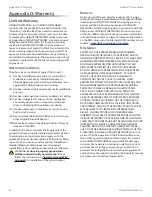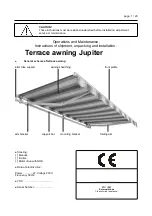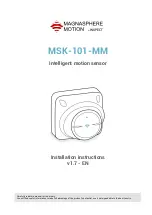
27
Chapter 8: Services Tab
airFiber
®
X User Guide
Ubiquiti Networks, Inc.
-
Key
Displays the key.
-
Comment
You can enter a brief description of the key.
-
Action
You have the following options:
•
Add
Adds a public key file.
•
Edit
Make changes to a public key file. Click
Save
to
save your changes.
•
Del
Deletes a public key file.
-
Save
Saves your changes.
-
Close
Discards your changes.
Telnet Server
The following
Telnet Server
parameters can be set:
Telnet Server
This option activates Telnet access to the
airFiber X radio.
•
Server Port
Specify the TCP/IP port of the
Telnet Server
.
NTP Client
Network Time Protocol (NTP) is a protocol for
synchronizing the clocks of computer systems over
packet-switched, variable-latency data networks. You can
use it to set the system time on the airFiber X radio. If the
Log
option is enabled, then the system time is reported
next to every log entry that registers a system event.
NTP Client
Enables the airFiber X radio to obtain the
system time from a time server on the Internet.
•
NTP Server
Specify the IP address or domain name of
the NTP server.
Dynamic DNS
Domain Name System (DNS) translates domain names
to IP addresses; Each DNS server on the Internet holds
these mappings in its respective DNS database. Dynamic
Domain Name System (DDNS) is a network service that
notifies the DNS server in real time of any changes in the
airFiber X radio’s IP settings. Even if the airFiber X radio’s IP
address changes, you can still access the airFiber X radio
through its domain name.
Dynamic DNS
If enabled, the airFiber X radio allows
communications with the DDNS server.
•
Host Name
Enter the host name of the DDNS server.
•
Username
Enter the user name of the DDNS account.
•
Password
Enter the password of the DDNS account.
•
Show
Check the box to display the password
characters.
System Log
System Log
This option enables the registration routine
of system log (syslog) messages. By default it is disabled.
•
Remote Log
Enables the syslog remote sending
function. System log messages are sent to a remote
server, which is specified in the
Remote Log IP Address
and
Remote Log Port
fields.
-
Remote Log IP Address
The host IP address that
receives syslog messages. Properly configure the
remote host to receive syslog protocol messages.
-
Remote Log Port
The TCP/IP port that receives syslog
messages.
514
is the default port for the commonly
used system message logging utilities.
Every logged message contains at least a system time and
host name. Usually a specific service name that generates
the system event is also specified within the message.
Messages from different services have different contexts
and different levels of detail. Usually error, warning, or
informational system service messages are reported;
however, more detailed debug level messages can also
be reported. The more detailed the system messages
reported, the greater the volume of log messages
generated.
Device Discovery
Discovery
Enables device discovery, so the airFiber X
radio can be discovered by other Ubiquiti devices through
the
Discovery
tool.
CDP
Enables Cisco Discovery Protocol (CDP)
communications, so the airFiber X radio can send out CDP
packets to share its information.
















































